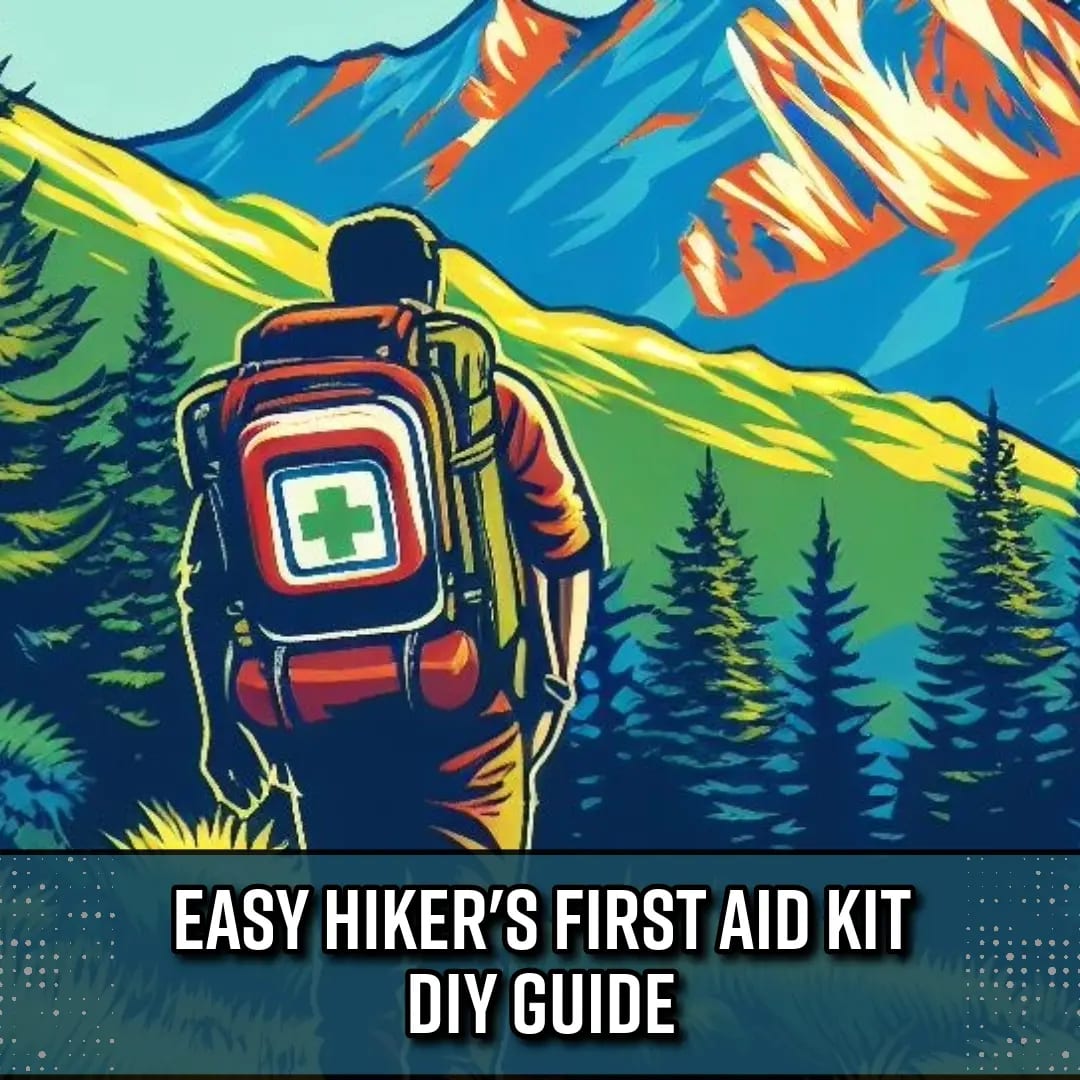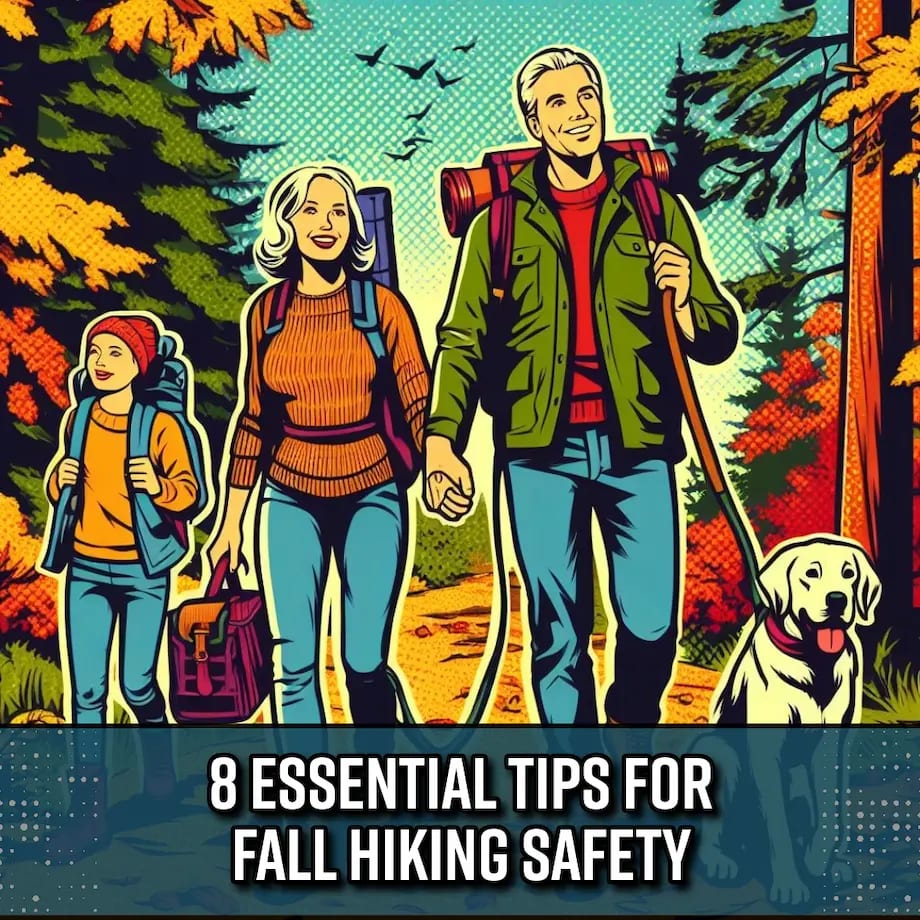The fall season, with the crisp clear air, lack of bugs, and changing leaves, is one of the best times of year to go hiking. As beautiful as it is, it’s still important to take precautions to ensure your safety while exploring the great outdoors. In this guide, we will go over some tips on fall hiking safety so you can have a safe and enjoyable hiking experience.
Key Takeaways
- Take into account the earlier sunset and the possibility of snowstorms and cold weather when planning.
- Check the weather forecast and pack the appropriate cold-weather clothing and essential hiking gear.
- Wear bright colors to improve visibility in areas where hunting may be taking place.
- Pay careful attention to the trail, as fallen leaves and nuts can make it challenging to navigate.
- Be aware of wildlife encounters and take necessary precautions when hiking in areas with moose, bears, or other large mammals.
Fall Hiking Safety Tips
When going on a fall hike, it’s essential to focus on safety by checking the weather and choosing your destinations with care. Fall weather can be unpredictable, with rapidly changing weather and trail conditions. By checking the forecast before heading out, you can prepare for a variety of weather conditions. This will help you pack the appropriate gear, such as extra layers for colder temperatures or rain gear for potential showers. Being aware of rain, snow, and shorter daylight hours is crucial for a safe and enjoyable fall hiking experience.
It’s also important to choose your hiking trails based on the weather forecast. If the forecast predicts cold or bad weather, it may be best to opt for a less challenging trail or postpone your hike. Always consider the safety risks before heading out. By being flexible and prepared to change your plans, you can mitigate potential risks and ensure a safer hiking experience.

1. Plan Accordingly Before Heading Out
Fall hikes require careful planning to ensure a safe experience. It’s important to remember that the sun sets earlier than you’re probably used to. Make sure you will have enough time to be off the trail before it gets dark. During the fall the weather can change quickly. Check the forecast before setting out so you will know what to expect. Don’t forget to account for any elevation changes that may occur during the hike.
2. Inform Someone About Your Hiking Plans
This is good advice all year long but before setting off on your hike, let someone your plans. Provide them with details about your intended destination and the estimated time of your return. This way, someone will be aware of your whereabouts and can take appropriate action in case of emergencies or delays.
3. Wear Layers of Bright Colors
Not only will bright colors add a pop of vibrancy to your hiking attire, but they also make you easier to see. This is critical if you are in an area that allows hunting, like much of the public land in America. Standing out against the natural backdrop can help prevent potential incidents and keep you safe.
By dressing in layers, and packing extra cold weather gear, you can stay comfortable as the weather changes. That’s enough detail for here because we have a guide on staying warm while hiking in the fall that covers it all.
4. Pack Accordingly for the Weather and Hike Intensity
We always recommend bringing a pack with the 10 essential items, first aid, extra food and water, spare socks, rain gear, and colder weather clothes. This way you are prepared in case things turn for the worse. Of course, keep in mind the weather forecast and the length of the hike when determining what you pack. Just keep in mind that even a short easy hike can go poorly so make sure you are prepared.
5. Stay Hydrated
It can be easy to forget to drink enough water in colder months because we don’t sweat as much and don’t get as thirsty. Even though you may not feel as thirsty you can still get dehydrated so drink often. One thing we do is plan to drink about a liter of water for every 2 hours hiking. Of course this isn’t a hard rule but it helps to keep track of whether you are drinking enough.
6. Pay Attention to the Trail
When hiking in the fall, one of the key things is to pay careful attention to the trail. Falling leaves and sticks can cover up, or even cause, potential dangers. Another hazard to consider is the nuts that fall in the autumn from nut-bearing trees. These nuts can create slippery conditions, especially on hillsides. It’s essential to tread cautiously, keep your eye on the trail, and take smaller steps. By being attentive and mindful of the trail conditions, you can ensure a safe and enjoyable fall hiking experience.
7. Watch Out for Wildlife Encounters
As we venture out on fall hikes, it’s important to be mindful of the wildlife we may encounter along the way. Fall is a busy time for animals as they prepare for winter, and hikers may come across them more frequently in their natural habitats. We need to take necessary precautions to ensure our safety and the well-being of the wildlife.
We have published a guide on bear safety for hikers that might be helpful if you are hiking in areas with bears. Bears aren’t the only animal that’s out in the fall so here are some general tips to keep you safe.
- Make some noise. When hiking in areas known for moose, bears, or other large animals. It’s easy to get lost in the peacefulness of the fall but it’s essential to make some noise to alert these animals of our presence. Anything that makes noise is helpful, but the human voice is best. Talking or singing, even to yourself, will let everything know that a person is nearby. Remember, we want to respect their space and avoid any unnecessary conflicts.
- Be cautious around snakes. Snakes seek sunny spots for warmth during the fall season, so it’s important to exercise caution when encountering them on the trail. Give them a wide berth and do not disturb or provoke them. Most snake bites occur when people attempt to handle or harass snakes, so maintain a respectful distance. You can read our guide on snake safety for more information.
- Mind stinging insects. In the fall, stinging insects like yellow jackets can be more aggressive as they protect their nests. Avoid getting too close to their nests and be aware of their presence. If you’re allergic to insect stings, make sure to carry the necessary medication and know how to use it in case of an emergency.
8. Know When to Turn Back
We love pushing our limits as much as anyone, but while hiking in the fall it’s important to know when it’s time to turn back. Weather and trail conditions can change rapidly. If you see signs that weather or trail conditions are getting worse it’s better to prioritize your safety and call it a day. This may mean cutting your hike short or even turning back before reaching your intended destination. The goal is to have a safe and enjoyable hiking experience, and that sometimes means making the difficult decision to turn around.

FAQ
Q: What precautions should I take for fall hiking?
A: It's important to plan your hike accordingly, taking into consideration the earlier sunset and the possibility of snowstorms and cold weather. Checking the forecast before leaving home and packing the appropriate cold weather attire and essential hiking gear is crucial.
Q: Why should I wear bright colors while hiking in the fall?
A: Wearing bright colors can improve visibility, particularly in areas where hunting may be taking place. It can also help alert wildlife, such as moose, bears, and other large mammals, of your presence and prevent potential encounters.
Q: How can I navigate safely on a fall hike?
A: Fallen leaves can make it difficult to navigate, so paying careful attention to the trail is essential. Using a map and compass, or a navigational app, can help you stay on the right path. It's also important to tread cautiously on nut-bearing trees, as they can create slippery conditions.
Q: What wildlife should I be aware of during fall hikes?
A: During the fall, wildlife activity increases. It's important to be aware of moose, bears, elk, snakes, and stinging insects like yellow jackets. Making enough noise to alert animals of your presence and giving wildlife a wide berth can help mitigate potential dangers.
Q: Why is it important to check the weather before a fall hike?
A: Fall weather can be unpredictable, so checking the forecast is crucial. Being prepared for changing conditions and choosing hiking destinations wisely based on the weather forecast can enhance safety during your hike.
Q: What should I do before heading out on a fall hike?
A: Inform someone about your hiking plans, including your intended destination and estimated return time. Pack the 10 hiking essentials, including navigation tools, extra food and water, appropriate clothing for changing weather conditions, and consider bringing a first aid kit and lightweight AED for additional safety.
Q: How do I know when to turn back during a fall hike?
A: If the weather or trail conditions deteriorate or if you're no longer comfortable continuing, it's better to call it a day and return home safely. Prioritize your safety and make wise decisions based on your comfort level and the conditions you encounter.
Before You Go …
Before you go we would like to recommend our related article on keeping your family warm and safe when hiking in cold weather. We hope that this article was helpful. If you liked this post please share with your friends and family. See you on the trails!
Related Blog Posts

Be prepared for any trailside emergency with our easy DIY guide to creating a hiker's first aid kit. Our expert tips will help you select the essential items you need to pack, from bandages and pain relievers to insect repellent and emergency blankets. Plus, our step-by-step guide shows you how to assemble and pack your kit for maximum convenience and accessibility on the trail.
By Summer and Bill

Summer and Bill are the dynamic duo behind Adventureite.com, a blog dedicated to inspiring others to explore the great outdoors. With a combined lifetime of experience traveling and adventuring across America, they have a wealth of knowledge to share. From hiking to camping, kayaking to travel, Summer and Bill are passionate about helping others discover the beauty of the natural world.
 Adventureite
Adventureite
